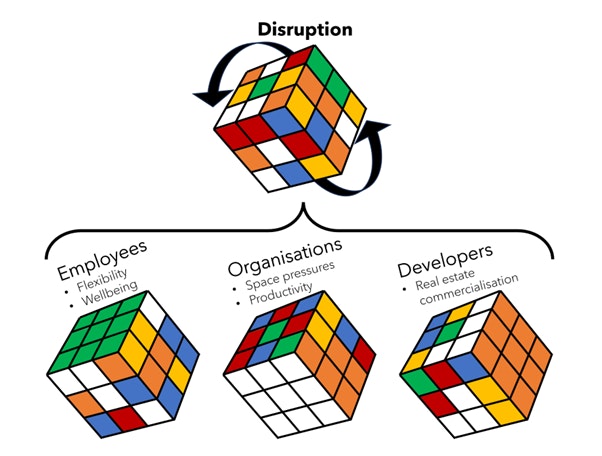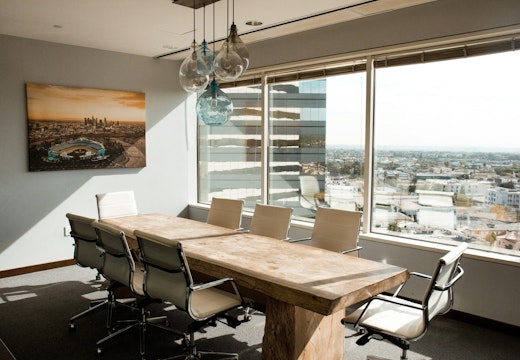The Where of Work: a multidisciplinary lens on coodinating the workplace
As work undergoes seismic shifts, new research highlights how coordinated strategies can solve challenges from different stakeholders to design interconnected workplaces
The past few years have brought unprecedented disruption to the world of world. From the Covid-19 pandemic to rapid technological advancements such as AI, and rising concerns around climate change, economic volatility and shifting employee expectations, society has been prompted to reconsider not just how we work, but where.
A new research study, conducted by Dr Agustin Chevez from the University of Melbourne, delves into this evolving landscape. The research paper entitled ‘The Where of Work’, unpacks the complex interplay of factors that influence where and how workplaces are financed, designed, delivered and utilised through the lens of different stakeholders.
Rubik’s cube of workplace
In Chevez’s research, the Rubik’s Cube serves as an analogy for the workplace, emphasising the interconnectedness of various stakeholders – employee, organisations and developers. Each stakeholder focuses on the side of the cube that directly affects their objectives. For instance:
- Employees prioritize flexibility and personal well-being.
- Organisations focus on space efficiency and cost management.
- Developers aim to ensure commercial relevance and market appeal.

However, as each stakeholder works to ‘solve’ their side of the cube, their actions inevitably impact the others’ objectives. Efforts to maximise flexibility for employees, for example, might challenge organisational goals around space utilisation, while developers’ decisions on building specifications could limit opportunities for workplace innovation. Chevez argues that this lack of coordination risks creating friction rather than harmony, underscoring the need for a more unified approach to workplace design and strategy.
The three groups of workplace stakeholders
The Where of Work research categorises stakeholders into three groups: users of workplaces; providers (those involved in the procurement of workplaces); and others affected by where people work (e.g., local government).

Chevez visualises these relationships through a social network map, revealing the intricate web of connections that influence workplace outcomes. Using a Power/Interest grid, participants assessed their key stakeholders based on current and ideal influence levels. This exercise highlights a critical insight: aligning stakeholders’ interests in more likely to produce effective workplace solutions than simply redistributing power.
Coordinating the cube
The findings of ‘The Where of Work’ research underscore the importance of addressing workplace challenges as interlinked parts of a single ‘cube’ rather than isolated problems. This approach requires a shift from siloed thinking to a more holistic mindset that recognises the mutual dependencies between stakeholders.
Chevez’s work suggests that a coordinated strategy – where stakeholders align their efforts to balance interests and optimise outcomes – can unlock the full potential of the workplace. This means:
- Designing workplaces that balance flexibility with efficiency.
- Delivering spaces that meet both employee needs and organisational objectives.
- Considering the broader impact of workplace decisions on communities and the environment.

In a world where the context of work is becoming ever more complex, ‘The Where of Work’ offers a framework for navigating this complexity. By embracing the Rubik’s Cube analogy and fostering collaboration across stakeholders, organisations can create workplaces that not only address today’s challenges but also capitalise on the opportunities of tomorrow.
As the lines between work, life, and place continue to blur, the question is no longer just where we work – it’s how we solve the workplace puzzle together.
 Dr Agustin Chevez is a workplace provocateur and an Honorary Fellow at the Faculty of Business and Economics at The University of Melbourne. He is also a member of SHE Lab at the Melbourne School of Design, The University of Melbourne. Chevez has previously spoken across the world at various WORKTECH events including Singapore, Sydney and Melbourne.
Dr Agustin Chevez is a workplace provocateur and an Honorary Fellow at the Faculty of Business and Economics at The University of Melbourne. He is also a member of SHE Lab at the Melbourne School of Design, The University of Melbourne. Chevez has previously spoken across the world at various WORKTECH events including Singapore, Sydney and Melbourne.







